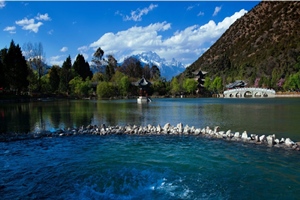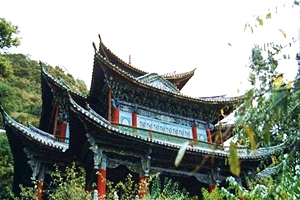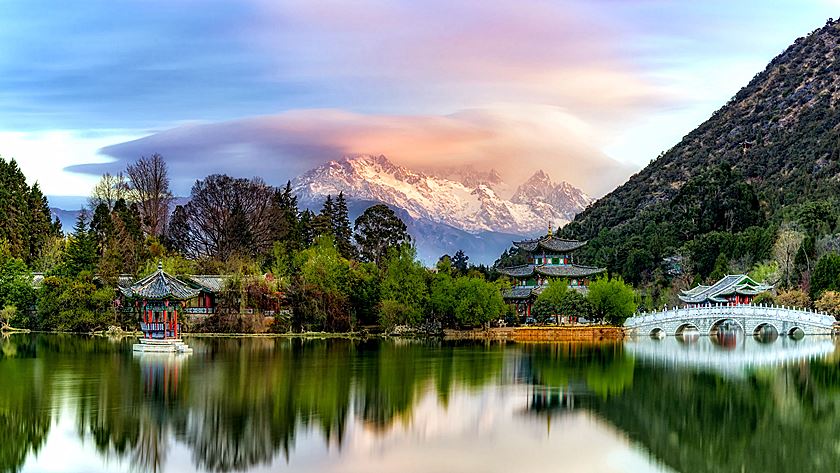Chinese Name: 黑龙潭公园 Pronunciation: Hēi Lóng Tán Gōng Yuán
Another Name: 玉泉公园 Pronunciation: Yǜ Quán Gōng Yuán
English Name: Black Dragon Pool Park or Jade Spring Park
Opening Hours: 07:00-19:00
Recommended Time for Visit: 1-3 Hours
Occupied Area: About 40,000 square meters (or 430,556 square ft)
Building Time: 1737
Best Visiting Time: May to December
Address: No.1 Minzhu Road, Old Town District, Lijiang, Yunnan Province, China(At the foot of Elephant Hill).
Popular Activities: Local people come together at the Dragon God Temple to pray and seek blessing in March every year.
Building Function: In the Qing dynasty, it was the place to worship King Dragon( the god in charge of rain) ) and pray for rain.
|
Ticket
|
Description
|
| 50 Yuan | For visitors who didn't pay for the Lijiang Old Town Maintenance Fee |
| Free | For visitors with the receipts of the Maintenance Fee |
Children under 12 years old or less than 1.2 meters in height are free of charge;
Seniors over 60 years old (with ID card) are free of charge;
People with disabilities (with disability certificate) are free of charge;
Soldiers in active service and retired cadres in the army are free of charge (with officer certificate).
National Model Workers and National Advanced Workers with valid certificates;
People whose registration residence in Lijiang or with a temporary residence permit in Lijiang;
*The above policy is only applicable to the admission fee

Black Dragon Pool Park (Heilongtan Park), also known as Jade Spring Park (Yuquan Park), is located in Lijiang, Yunnan Province. Exactly speaking, the park is located at the foot of the Elephant Mountain (Xiangshan), about 1 kilometer in distance in the north of the Lijiang Old Town, with an altitude of 2500 meters.
The so-called Black Dragon Pool is a crystal clear spring lake indeed, which was called Jade Spring for its clear water in a long history. The spring water gushed out from the crevices of the stones along the mountain and gathered into the pool. The Jade Dragon Snow Mountain will show her face and be reflected in the serene lake on sunny days.
There are several ancient architectures surrounded the lake and decorated the lake in the park, such as the Suocui Bridge, the Longshen Temple, the Hanyue Stage, and the Deyue Pavilion. The Lijiang Museum, or say Dongba Culture Museum is also seated in the park.
The Dragon Temple was built three times in the Qing Dynasty, in the second year of Qianlong (1737), in the seventeenth year of Jiaqing (1812), and the fifteenth year of Guangxu (1889). Jade Spring was twice titled “Longshen” (Dragon God) by the emperor and afterward became a famous spring in China.
Black Dragon Pool was first built in the second year (1737) of the reign of Emperor Qianlong in the Qing Dynasty. Black Dragon Pool was repaired twice in the Qing Dynasty, one was in the sixtieth year (1795) in the reign of Emperor Qianlong and the other time was in the eighteenth year(1892) in the reign of Emperor Guangxu, which can be verified in the historical record.
Black Dragon Pool was called Jade Spring Dragon King Temple in history. The residents of the surrounding villages came here to worship and pray. The temple was bestowed “Longshen” (Dragon God) successively by two emperors in the Qing Dynasty, one is Emperor Jiaqing and the other is Emperor Guangxu. Afterward, the place changed its name to Black Dragon Pool. Nowadays, some people called the place Jade Spring Park while some others called it Black Dragon Pool.
There is one thing that never changes that the Black Dragon Pool is always a crystal clear beautiful spring lake. Black Dragon Pool with its natural beauty, is listed in the books China Famous Spring, China Scenic Spots and so on.
The front door of the Black Dragon Pool Park is a gold-painted archway. There are four beautiful and majestic stone lions seated in the front door to protect the Black Dragon Pool. The lions were moved to this park in 1966 from the Mu Fu Mansion.
In the center of the Black Dragon Pool, stands a three-storey pavilion, which is surrounded by water in four directions, only with a bridge connecting it to the shore. The pavilion was called Deyue Pavilion, which was first built in 1876. The name of the building is taken from the ancient couplet “The pavilion near the water will be the first to see the inverted reflection of moon in the water; the flowers and trees towards the sun will be the first to grow in the springtime” (“yue” means moon in English). The pavilion was rebuilt in 1963, and the famous writer Guo Moruo inscribed for the gate plaque and wrote two couplets for the pavilion.

The Deyue Pavilion, a three-story building, is seated in the center of the lake, which was first built in 1876, rebuilt in 1963. The pavilion, which is on the same axis with the Hanyue Stage, is connected with the bank by the bridge. A pair of couplets, written by the famous Chinese writer Guo Moruo, was shown on the pavilion’s gate. Here was a place where used to research Dongba culture (a culture created by Naxi Minority).
The Longshen Temple once called Longwang Temple, was first built during Emperor Qianlong's reign in 1737 in the Qing Dynasty, which was on the main axis of the park. 'Longshen' means Dragon God in Chinese, who is the God of Rain, in charge of rain in Chinese mythology. The local people pray and seek blessings in this temple. However, the old architecture was burned down in 2003. The ancient Naxi music played for visitors for free.

Located in the north of the park, the Five-Phoenix Tower, also known as Fayun Pavilion, was moved from Fuguo Temple in 1979, first built-in 1601. The three-story tower is 23 meters in height, though is in the Naxi style but was more or less affected by the architectural style of the Bai minority, Tibet, and also Han nationality. The tower is well decorated with colorful paintings and marvelous carvings. The tower is tall with three layers.
Located in the south of the park, Dongba Culture Museum, also known as Lijiang Museum, collected thousands of pieces of objects or materials related to Dongba culture. The museum was built in a developing Naxi style. The performances of Dongba sacrificial ritual are shown to visitors here.
Dragon is a symbol of power, nobility and honor in Chinese traditional culture, and also a symbol of luck and success. Dragon is the master of the undersea world (people call the master Dragon King) in mythology, the symbol of the auspicious among people and the embodiment of imperial rule in the feudal period. Dragon King is one of the four symbols in ancient Chinese myths and legends and it is in charge of clouds and rainfall. People believe that Dragon Kings live in water, including sea, river, and the deep pool.
In a story, the Dragon King of Black Dragon Pool was a lady-killer, who often went to villages to find girls he likes and left the undone work of controlling the water. When he heard that the old Dragon King of Laojunshan Dragon Pool had a single child, a beautiful unmarried daughter, his mind is perturbed for the girl. After some preparation, he left his pool and went to the old Dragon King's palace in Laojunshan Dragon Pool to propose.
The dragon girl fell in love with the Dragon King of Black Dragon Pool at first sight. They were immersed in sweet love and forgot the time. They stayed together day after day. The Dragon King of Black Dragon Pool forgot to go back home and left his mission behind his head completely. The water of Black Dragon Pool was totally out of control, up and down irregularly, which caused complaints from the local people. The Dragon King of Black Dragon Pool was punished for neglecting his duty by the Jade Emperor(The ruler of heaven, one of the highest ranking gods, and the very first of the Chinese emperors) when he got to know the complaints.
The Dragon King of Black Dragon Pool came back to his home, but his heart still stayed in the Laojunshan Dragon Pool where the beautiful dragon girl lived. And every year when the spring came, the Dragon King would leave his duty to undo and secretly left Black Dragon Pool to Laojunshan Dragon Pool to meet his lover. During his dating time, the water of the Black Dragon Pool would decrease and even dry up.
When the water volume in the Black Dragon Pool become lesser, people from all the neighboring villages would offer a sacrifice to the Dragon King and pray for rain. However, the Dragon King people sacrificed to was not the Dragon King of Black Dragon Pool but the old Dragon King of Laojunshan Dragon Pool. People offered sacrifice to the old Dragon King to ask him to let his son-in-law, the Dragon King of Black Dragon Pool, come back to Black Dragon Pool to make rain.
Bus Lines: No.3, No.4, No.6, No.7, No.8, No.9, No.13, No.20, or No.28
Bus Stop: 黑龙潭(Hēi Lóng Tán),Black Dragon Pool Park
By Taxi
Chinese: 请带我去黑龙潭。English: Please take me to the Black Dragon Pool Park.
If you go to the Black Dragon Pool Park from the Lijiang Renming Square, it takes about 12 minutes (about 20 yuan).
